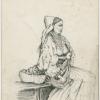‘Croat Woman in the Agram Market’
Page featuring an engraving (made after a drawing by Arthur Evans), captioned ‘Croat Woman in the Agram Market’, published in Arthur J. Evans, Through Bosnia and the Herzegóvina on Foot during the Insurrection, August and September 1875 (London, 1876), p.9.
Artist: Unidentified engraver, after an original drawing [1941.8.179] by Arthur John Evans
Date of publication: 1876
Continent: Europe
Geographical area: Southern Europe
Country: Croatia
Region/Place: Zagreb
Cultural group: European Croat
Format: Woodcut engraving
Page size: 234 x 141 mm
Acquisition: Henry Balfour. Bequeathed February 1939
***
Research notes: It has been identified by Philip Grover that this woodcut engraving by an unnamed artist was based on an original drawing [1941.8.179] by Arthur John Evans, being the portrait of a Croat woman seen in the market place of Zagreb. It was published in Evans’ account of his journey, Through Bosnia and the Herzegóvina on Foot during the Insurrection, August and September 1875 (London, 1876), p.9, printed with the caption ‘Croat Woman in the Agram Market’. Evans recorded in the volume: ‘The market place is a spacious studio. The beauty of the Croatian peasant costume is almost unique in Europe - possibly only rivalled at Belgrade. [...] In the Agram market-place, not only the colours, but the very materials, might have been chosen by an artist. [...] The head-dresses of these village ladies are varied, for every hamlet has its speciality of costume. [...] On some, from St. Ivan, the transparent white kerchief falls about the bust and shoulders lightly as a bridal veil; on others it takes a rosier hue, and is known as the Rubatz. On others, again, as those from Zagoria - who will have it that they are great grand-daughters of Avars - it is drawn backwards over a long silver pin, stuck horizontally across the hair, and depends over the back till its variegated border and long fringe sweep the girdle. [...] In place of a skirt they generally wear two wide overlapping aprons, one before and one behind, which in a gale of wind may afford occasional studies for a Bacchante ! and over the front one of these hangs a narrower apron starred with red asterisks, crossed by little zigzagging patterns, or by light transversal bands of rose and lilac. But enough of such pallid hues! The pride of their toilette is a brilliant crimson scarf, the Pojas, wound round the waist, some of the folds of which are at time loosened and hang down over the front apron in a graceful sing or outside pouch. [...] Round their necks hangs an array of what politeness would have me call coral necklaces. Occasionally they wear silver ear-rings, silver pendants on their breast, and rings on their fingers’: Through Bosnia and the Herzegóvina on Foot, pp.7, 8, 9–10. Note that Agram is the German name for Zagreb, Croatia.

